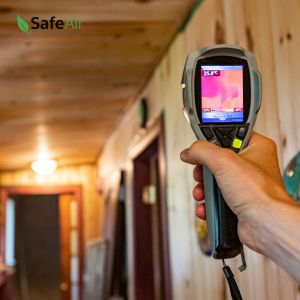What Are The Symptoms of Poor Air Quality in a House
Posted in Air Quality, on December 14, 2023
Indoor air quality testing is pivotal in ensuring your health and wellness at home. At SafeAir, we help families improve their indoor air environment through comprehensive air quality testing to enhance respiratory health and indoor comfort. Bad air quality is characterized by high levels of pollutants, allergens, and contaminants that pose risks to your body. Paying attention to when and why poor indoor air quality is happening in your home is the first step in solving these issues and feeling better.
Common Symptoms of Poor Air Quality in a House
 Indoor air quality problems manifest through common symptoms that often mimic the common cold or flu. Persistent respiratory issues, such as coughing, wheezing, or shortness of breath, are the most commonly reported; sneezing and itchy eyes are usually the second. Many of SafeAir’s clients also report headaches that clear up outdoors or out of the house and unexplained fatigue or dizziness.
Indoor air quality problems manifest through common symptoms that often mimic the common cold or flu. Persistent respiratory issues, such as coughing, wheezing, or shortness of breath, are the most commonly reported; sneezing and itchy eyes are usually the second. Many of SafeAir’s clients also report headaches that clear up outdoors or out of the house and unexplained fatigue or dizziness.
Indoor air quality problems can sometimes be detected using the senses, but just because there’s no smell doesn’t mean you don’t have a problem. While mold has a distinct musty odour, other issues, like radon gas, have no smell at all.
Causes of Poor Air Quality in a House
Indoor air quality testing may reveal several different pollutants affecting your home and often discovers a surprising system of cause and effect. The most frequently reported causes of poor indoor air quality include:
- Inadequate or limited ventilation.
- Mold growth.
- Artificial scents.
- Indoor tobacco or marijuana smoking.
- Pet dander.
- Pollen and outdoor pollutants.
- Combustion byproducts from poorly maintained appliances.
Prevention and Solutions
SafeAir’s air quality testing offers crucial solutions for healthier indoor environments. This comprehensive testing regimen takes a deep dive into the where, when, why, and how of your home’s unique air quality challenges — and offers a range of solutions and preventative strategies for the future. Some of the things we commonly recommend include:
- Increasing ventilation in critical areas.
- Using a dehumidifier, especially in basements.
- Insulation improvements in the attic or basement.
- Installing a HEPA air purifier or filtration system.
- Using VOC-free products when renovating.
- Eliminating scented cleaning products and air fresheners.
- Maintaining your HVAC system by regularly changing filters.
- Radon testing
- Air quality tests before or after construction projects.
Working with SafeAir For a Healthier Tomorrow
Don’t rely on your nose to tell you when something’s wrong — work with SafeAir’s professional, science-based testing protocol to improve your indoor air quality at home. While sneezing or coughing sounds like a minor irritation, they can cause chronic problems after weeks or months and begin to affect all aspects of your life. Absenteeism, missed school, and poor energy levels are only the start — increased respiratory problems like asthma attacks, a decrease in cardiovascular health, and damage to your property can be some of the more severe outcomes.
With indoor air quality testing, your home’s whole environment is double and triple-checked for various air quality factors. Don’t let invisible air pollution compromise your home.

